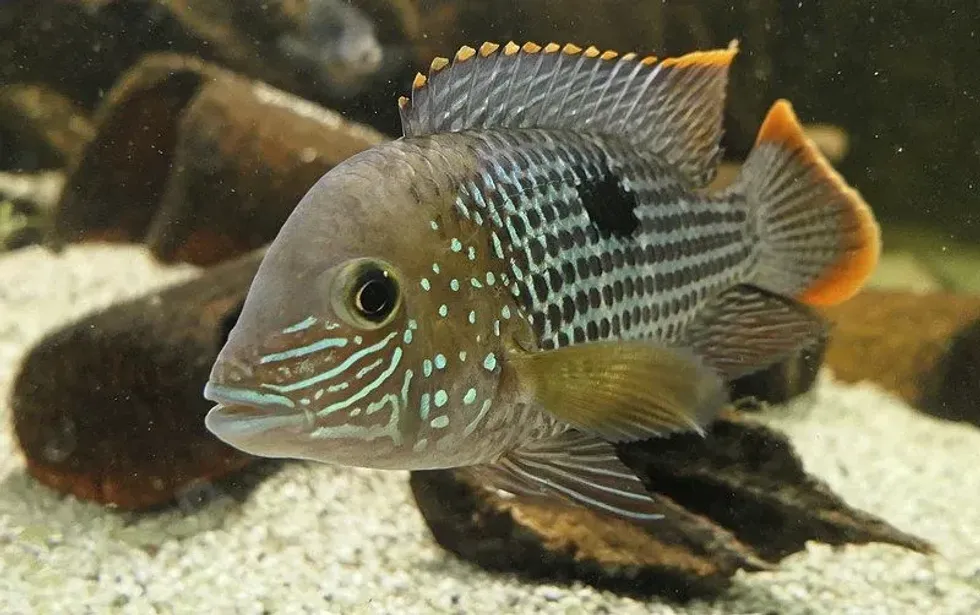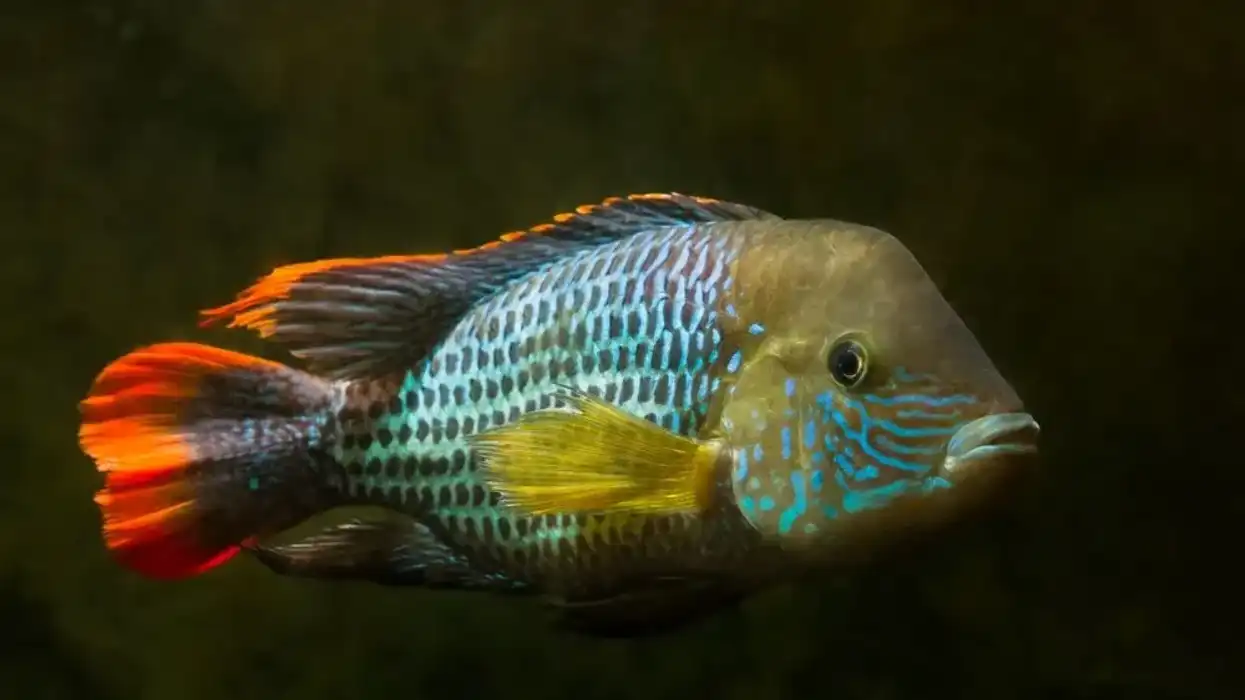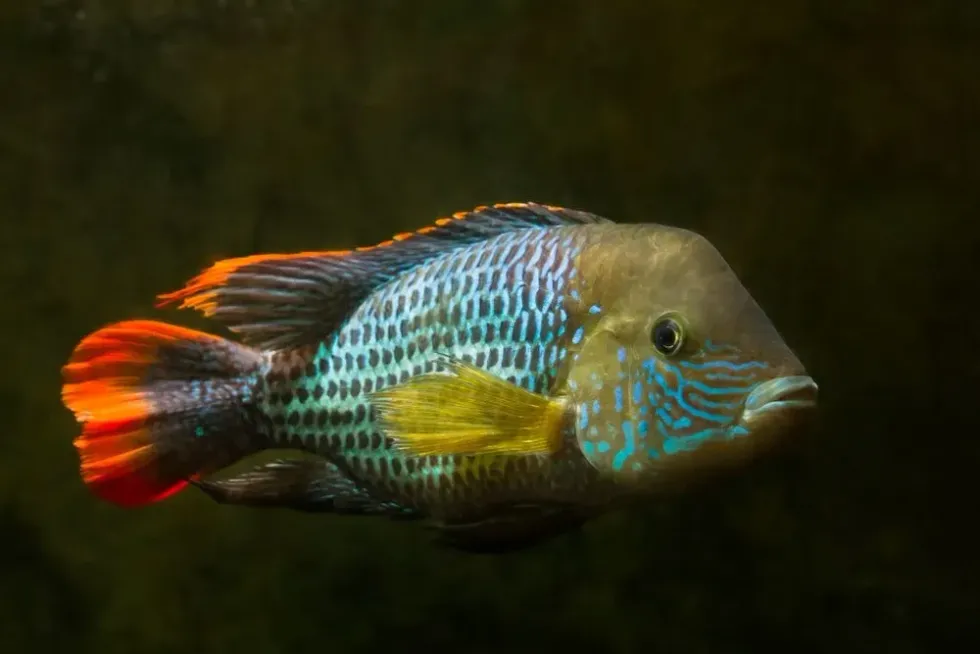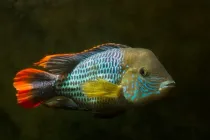Fun Green Terror Facts For Kids
Green terror fishes are a colorful species of freshwater fish that belong to the cichlid family. Green terror cichlids are large yet slender-bodied fish with lengths reaching between 8-12 in (20-30 cm) and a weight of 3.2 oz (90.7 g). This fish is also known by its scientific names which are Andinoacara rivulatus or Aequidens rivulatus.
Green terror juveniles and adult green terror cichlids are often territorial and aggressive in nature, especially females. Male green terror cichlids are always larger in size than female green terrors, and they have a distinct feature that differentiates them from females.
This feature is a significant hump or protrusion on their forehead that female fishes don't possess.
The males of this species are much larger, but the females are a more aggressive fish. Females tend to get aggressive, especially when they are in the spawning season, but other than this they are fairly tempered.
Green terror cichlids are often kept in large aquariums, these fishes are valuable both in price and rarity. They are easy to care for as the only thing they require is fresh, clear water and vast space in the aquarium tanks.
Male and female green terror cichlid species tend to stay in pairs, this is because they go through a breeding period every two weeks after they have matured.
Here on our page, we have many amazing facts about the green terror that everyone will enjoy. Let's look at these interesting facts, and if you like these, then do also read our cichlid and pinfish facts.
Green Terror Interesting Facts
What type of animal is a green terror?
Green terrors (Andinoacara rivulatus) are a species of large, healthy, and colorful fishes of the cichlid family. Although the name of this species indicates that they are green-colored fishes, they are not necessarily green in color at all.
Green terrors are mostly found in an electric blue color with white and green patches across their body. The edges of their dorsal fin tend to be a warm orange color.
What class of animal does a green terror belong to?
The bright and large green terror cichlid is a species of fish that belongs to the class of actinopterygii.
How many green terrors are there in the world?
Green terror fishes are far-reaching and found throughout different areas of the world from South America to Peru and Ecuador. Their populations were estimated to be in the millions across all freshwater regions across the world and they are not on the list of endangered species.
The exact population of green terrors is still unknown, but they are safe, healthy, and can be found in abundance.
Where does a green terror live?
Green terror cichlids are a large fish family that live in tropical freshwaters, river basins, and calm streams in Peru, Ecuador, and South America. These large cichlids originated from the Pacific Ocean, Peru's Thumbes River and Esmeralda River in Ecuador.
They are, therefore, said to be natives of South America and can have a lifespan of between seven to ten years of age.
What is a green terror's habitat?
Green terror habitats lie in the clear waters of the Pacific Ocean. These fishes are also found on coastal slopes as they inhabit all freshwater, but they tend to avoid brackish water and choose to live in calm blue waters.
In captivity, green terror fishes are often held in large aquariums or green terror tanks. They are widely popular as these fishes are easy to care for, and the only necessity they require in an aquarium is fresh water and food.
Who do green terrors live with?
Green terror cichlids (Andinoacara rivulatus) are large fishes with a splendid metallic blue and royal green sheen across their body. Due to the standard green terror size, this fish can be incredibly hostile towards other fish, threatening fights with even larger cichlids sometimes, especially during their breeding season.
They usually live alone or in pairs. When keeping a green terror cichlid, it is important to have a tank large enough to fit other tank mates, decoration and adequate water.
How long does a green terror live?
Green terrors have a lifespan of up to seven to ten years of age in captivity and the wild. There are certain factors that will either decrease or increase the lifespan of these fish.
They can live much longer if they are well cared for, provided with a natural habitat, and do not catch any diseases. Because of their long lifespan, green terror cichlids are kept as pets in large aquariums across the world.
How do they reproduce?
These aggressive fish are open breeders. This means the female will lay eggs and store them first, after which the males fertilize the eggs in open water.
Good water quality and great tank conditions should be enough for green terrors to reproduce successfully. Warm water temperatures of about 77-80°F (25-26 °C) should help the pair come together to spawn.
The pair will clean the chosen site before spawning, and the chosen sites usually consist of a flat stone or rock. If not, they will clean the lower part of the tank of sand and lay eggs on the glass surface.
Females will lay anywhere between 400 to 600 eggs. A yellow tone is a good sign of well-developed eggs, which will then hatch in three or four days.
Green terror cichlids (Andinoacara Rivulatus) are fantastic guardians, and it would be wise to keep them close to their eggs and fry. Fry can be fed with dry food, brine shrimp, and tiny worms.
What is their conservation status?
Green terror cichlids are categorized as Least Concern by the IUCN. These fish are not Extinct, and conservation efforts do not have to be focused on them as they are constantly breeding. They lay a large number of eggs, roughly 400 to 600 in number, and can take care of themselves fairly well.
Green Terror Fun Facts
What do green terrors look like?
Green terror cichlids are a bright-colored and slim fish with pointed dorsal fins. Males have bright green and blue metallic tones with an orange lining along the edge of the dorsal and caudal fins.
Females are altogether cloudier in color, with a less articulated striped orange coloring on the dorsal and caudal fins. Every now and then, this stripe is missing among females.
They likewise have different shades of blue, pink, or red. Tones tend to change among adolescent and grown-up fish, with adolescents having stronger bright blue and orange tones than grown-ups.

How cute are they?
Green terrors are not the most pleasant-looking wild fish species in the water, but they sure are cute and very much in demand when people choose fish for their aquarium. Their metallic blue color with orange edges on the dorsal fins makes them very distinguishable from other cichlid species.
Most people find them cute because of their patterned color and aesthetics, but it all depends on the preferences of each individual.
How do they communicate?
There hasn't been much research done on how green terrors communicate with each other other than when they are breeding, but it has been observed that green terrors show an aggressive temperament toward other fishes and prefer being left alone. Similarly, they show a peaceful temperament when taking care of their fry.
How big is a green terror?
The smallest green terror cichlid found was up to 8 in (20 cm) long, and the biggest green terror found was 12 in (30 cm) in length.
How fast can a green terror swim?
The average speed of a green terror has not been estimated yet. But it is said that this species of fish can swim quite fast, this is because the front part of their dorsal fins are a shape that is perfect for the green terror to navigate effortlessly in open waters.
How much does a green terror weigh?
The weight of a green terror depends on its size. The average weight of an 8 in (20 cm) long green terror is around 0.2 lb (0.1 kg).
What are the male and female names of the species?
No specific names have been recorded for the females and males of this species. They are simply referred to as male green terrors and female green terrors. However, it is easy to identify the sexes, as males have a large hump on their forehead while females do not.
What would you call a baby green terror?
Baby green terror fishes are referred to as fry when they are young. When they are just eggs, the male fertilizes them and guards them while the female takes care of them. When the eggs hatch, the young fry are fed with small plants and brine shrimps.
What do they eat?
Green terrors are omnivores, so their diet consists of ocean plants and small fishes such as bloodworms, brine shrimps, tubifex, and plankton. The cichlid species are very picky eaters and love to eat frozen food, mostly frozen krill and cichlid pellets.
Are they aggressive?
This species are beautiful freshwater fishes that can bring fascinating experiences to your tank. In spite of green terrors being so huge, they are not difficult to handle, but they do tend to be very aggressive. So these fishes are best left to more experienced aquarists.
Would they make a good pet?
They would make great pets, but they can be lousy tankmates to certain other fish.
They are good tank mates with most smaller fishes, but there is always the possibility of them eating smaller fishes, or intimidating a bigger fish with their aggressive behavior.
One must have an aquarium with a minimum water capacity of 35 gal (159 l) for a lone green terror and up to 75 gal (318 l) water capacity for a pair.
If the tank is too small the fishes may fight over territory and won't be good tank mates to each other.
Did you know...
Green terrors are fishes that grow very fast. These fishes rapidly grow close to 10 in (25 cm) long in just five months.
Green terror cichlid fishes do not have eyelids, which is why they sleep with their eyes wide open.
These species of fishes have a multitude of tactics that they use to catch their prey easily. At times, they mimic the sound and color of harmless fishes to grab the attention of their prey. These fishes also love to play dead so that other fishes come close and that they can then snatch them easily.
Male green terrors can be both polygamous and monogamous animals.
It is not necessary for green terrors to only one mate for their whole life, but both male and female green terrors are devoted parents towards their young and often take care of the young fry for several weeks until they are sure that the young fish are old enough to swim and survive on their own.
Having your own green terror
Green terrors are often kept in large aquariums as these fishes are very valuable, and it is easy to take care of them. If your intended green terror tank size is not large, it is best that you only get one fish, provided there is still a minimum of 35 gal (159 l).
However, if you can afford a larger aquarium, try keeping a pair instead, as these fishes like to be together.
Green terrors can also be kept with other species of fishes if they are larger or of a similar size and temperament to them. Species which would be good tank mates with them are large characins, large cichlids, and silver dollars.
Green terror care and upkeep is very easy as they are a tough and long-lasting species of fish that just want the bare minimum which includes clean water, live food, pellets, and flakes in the aquarium. This species of fish are omnivores and can feed on veggies, plants, small crustaceans and fish.
Try not to feed these fish over two times a day as this could cause digestive problems for the green terror fish.
Why is it called green terror?
Green terrors got their name because they are wildly hostile fish that show aggressive and territorial behavior towards other fish and often require a large space of their own. Green terrors also get very wary of their tank mates during the breeding and spawning period.
Here at Kidadl, we have carefully created lots of interesting family-friendly animal facts for everyone to discover! Learn more about some other fish including tetra, or tang fish.
You can even occupy yourself at home by drawing one of our Green terror coloring pages.
We Want Your Photos!
More for You
See All
Bachelor of Commerce specializing in Accounting and Finance, Master of Business Administration

Divya RaghavBachelor of Commerce specializing in Accounting and Finance, Master of Business Administration
With a diverse range of experience in finance, administration, and operations, Divya is a diligent worker known for her attention to detail. Born and raised in Bangalore, she completed her Bachelor's in Commerce from Christ University and is now pursuing an MBA at Narsee Monjee Institute of Management Studies, Bangalore. Along with her professional pursuits, Divya has a passion for baking, dancing, and writing content. She is also an avid animal lover who dedicates her time to volunteering for animal welfare causes.
Disclaimer
1) Kidadl is independent and to make our service free to you the reader we are supported by advertising. We hope you love our recommendations for products and services! What we suggest is selected independently by the Kidadl team. If you purchase using the Buy Now button we may earn a small commission. This does not influence our choices. Prices are correct and items are available at the time the article was published but we cannot guarantee that on the time of reading. Please note that Kidadl is a participant in the Amazon Services LLC Associates Program, an affiliate advertising program designed to provide a means for sites to earn advertising fees by advertising and linking to Amazon. We also link to other websites, but are not responsible for their content.
2) At Kidadl, we strive to recommend the very best activities and events. We will always aim to give you accurate information at the date of publication - however, information does change, so it’s important you do your own research, double-check and make the decision that is right for your family. We recognise that not all activities and ideas are appropriate for all children and families or in all circumstances. Our recommended activities are based on age but these are a guide. We recommend that these ideas are used as inspiration, that ideas are undertaken with appropriate adult supervision, and that each adult uses their own discretion and knowledge of their children to consider the safety and suitability. Kidadl cannot accept liability for the execution of these ideas, and parental supervision is advised at all times, as safety is paramount. Anyone using the information provided by Kidadl does so at their own risk and we can not accept liability if things go wrong.
3) Because we are an educational resource, we have quotes and facts about a range of historical and modern figures. We do not endorse the actions of or rhetoric of all the people included in these collections, but we think they are important for growing minds to learn about under the guidance of parents or guardians.







